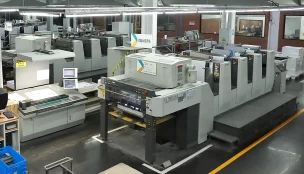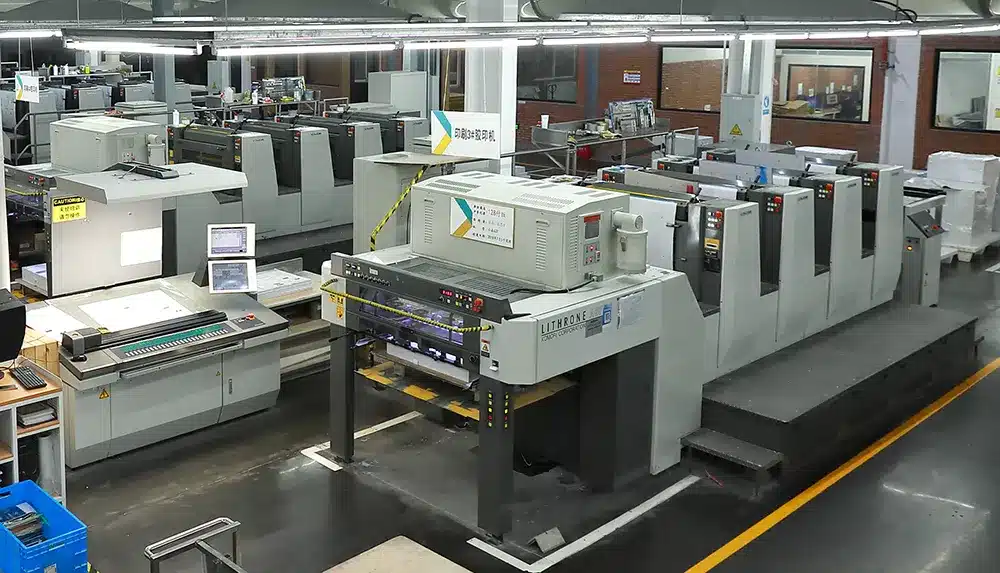We clear up the confusion between digital and offset methods of printing and explain when each is the better option for your print project
Quantity or quality?
You can look at the question of the difference between digital and offset printing from two perspectives: that of the customer and that of the printer. The commercial and the technical, if you like. We'll explain the key technical differences in just a moment.
It's often thought — mistakenly — that the core difference between digital and offset printing is in the resulting product: that one is better quality than the other. But in fact, it's more likely to be a question of volume, of quantity, which will be the decider for most customers. Both techniques are capable of beautiful, high-quality reproduction of both text, photographs, and graphics.
But what you may want to know straightaway as a potential print customer is that, as a rule, if you only need a few copies — say from a single copy to no more than 100 — it may be that digital printing will the cheaper and most efficient choice. On the other hand, if you need hundreds or thousands of copies of a project — leaflets, brochures, books — then offset printing is probably the way to go.
So, that's an important general distinction. But, you're right if you're thinking that it doesn't tell you much about the essential differences in these two ways of printing products. So, let's dive into the technical side for a moment.
Digital printing technology vs offset printing technology
The fundamental difference between offset and digital printing lies in the machinery used and the way the ink is applied to the surface of the paper. There are cost implications, too, which are obviously an important consideration for customers and we'll examine those in a moment. First, offset printing.
Offset printing process
Offset printing — or offset lithography as it is also known — is a three-step process. First, an etched metal plate is created for each color or sheet and the plate is then fixed around a rotating cylinder called, not surprisingly, the ‘plate cylinder'. The plate has an image etched flush with the surface and the printable and non-printable areas are distinguished by being either oily or aqueous.
As the metal cylinder rolls it comes into contact with a rubber sheet wrapped around — you guessed it! — the rubber cylinder. The inked image is first transferred to the rubber roll and then onto another cylinder — the impression cylinder — which carries the paper. So, the printing is ‘offset' onto the surface of the paper. It's way more complicated than that in the details, but that's how it works in a nutshell.
Each sheet requires its own plate. So, the setup and run time associated with offset printing is fairly long. But if you're printing thousands of copies — a ‘long run' — then it will work out cheaper than digital regardless of the number of sheets.
Digital printing process
Digital printing is also all about rollers — in this case known as ‘drums' — but it's a less complex setup and transfer process. The drums carry an electrostatic charge which transfers toner — toner is a powder, by the way, unlike ink, which is a liquid — onto the paper surface where it is then ‘fixed' in a separate unit by exposure to intense heat.
Digital printing generally enjoys a faster turnaround time compared to offset. But at large volume it can be much more expensive. And while the quality of the finished product should always be high, there are several other factors to take into consideration, which we'll look at now.
Size matters
The size of the sheets that can be loaded onto the printing machines can make a huge difference to certain important print projects. And this is another key consideration when it comes to the difference between digital and offset printing. Let's look at why.
Some digital printing machines can handle a sheet size up to a maximum of 29 inches, although typically you're looking at up to about 19 inches. Whereas an offset printing machine can hold a sheet right up to a whopping 40 inches.
Quite a few popular print projects just can't be done digitally because of the size limitations of digital machines. So, for large posters, the bigger book formats, and a lot of custom cardboard box and packaging designs, for example, you'll need to go with offset printing for technical reasons alone.
Color counts
With full-color digital printing you can achieve a good range of colors. Digital presses use a color space called CMYK. It's a system based on four colors: cyan, magenta, yellow, and black. While the quality of reproduction is good using these colors, it's never an exact reproduction of ink colors. So, if you need 100% color faithfulness — say for precise branding or an art book — then digital may not quite deliver the goods color-wise. But for your flyers, basic brochures, and so on, it's likely plenty good enough to meet your needs.
Offset printing has the advantage over digital in terms of color reproduction. If your business needs an invariable and accurate adherence to color, for example because of branding, offset is the way to go. Certainly, for reproducing art works, offset is a must. Offset uses premixed inks which sustain precise color faithfulness even after printing, drying, and coating.
Paper potential
We're passionate about paper and while the potential for improved digital machines to handle heavy or more textured paper stocks is continually improving, there are still significant differences between digital and offset printing. As a rule, a digital press can run any of the standard paper weights without difficulty and give you a great result. But if you want to use heavier stocks or papers with specialist finishes, then offset may be the best — or even, only — option you have.
Special processes
Specialized finishes and processes such as foil stamping, embossing, debossing, varnishing, UV coating, and so on are better suited to offset printing and can't generally be reliably applied on digital machines. These are important factors to take into account from the outset. If you have a hardcover coffee table book printing project in mind, for example, that will require special flourishes on the covers and gloss coated paper in the interior, then the paper stock, color space, and printing technology all need to be considered right from the start of the design process to make sure you get an efficient and effective result, and that the project can be achieved within budget.
Turnaround times
As a general rule — because the setup is much simpler — digital printing offers you a much faster turnaround time from ordering to delivery than offset printing. But again, you need to balance this advantage against the other factors such as the cost if you need a large run, limitations on paper size, color reproduction, finishes and coatings.Clearly, which you choose will depend on the project itself and your business needs. If you need a short run of time-limited promotional flyers, for example, then digital printing will answer your needs. If, on the other hand, you're publishing a specialist product catalog for global distribution — and hence, many thousands of copies — you'll probably choose offset.
Let's talk!
But don't worry if you're not sure which kind of printing will best suit your needs. Talk to us. We have decades of experience in the printing industry and have a deep understanding of all the pros and cons of the different processes. We also use state-of-the-art machines for both digital and offset printing, so whatever your needs, we can answer them. Get in touch today for a no-obligation quote or just to chat through your ideas with one of our friendly, expert team members. We look forward to helping you get the best print deal possible both in terms of pricing and product quality.








